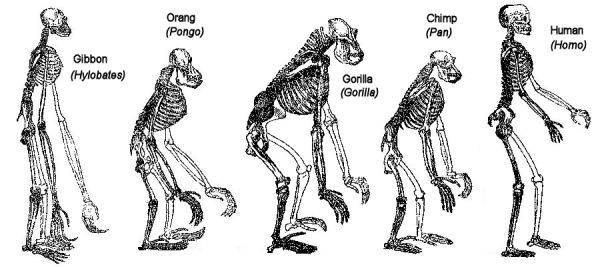

Traditional versus Phylogenetic
classifications of anthropoid primates
Traditional
classification is based on recognition of groups
of similar organisms, as indicated by the brackets at right. The
Anthropoid ("man-like") Apes are those relatives of Old
World Monkeys (Cercopithecidae),
in which the tail is absent. The traditional taxonomy is
influenced by the perception [or wishful thinking] that the
Great Apes (chimps, gorillas, & orangutans) (Pongidae)
are very distinct from Homo,
who should therefore be
placed in a separate group (Hominidae). Among the
tailless apes, gibbons and siamangs are perceived as more "monkey-like",
and are placed in a separate subfamily Hylobatinae.
Phylogenetic
classification assigns names to monophyletic
lineages, as indicated by the names on tree branches. Among the Anthropoidea,
gibbons and the Great Apes (including Homo) are
recognized as separate evolutionary lineages, and are placed in
separate families (Hylobatidae & Pongidae,
respectively). Within the latter, Homo, Pan,
& Gorilla are a closely related group recognizable
as a subfamily, Gorillinae. Given the recognition that Homo
and Pan are each others closest living relatives, they
can be recognized as a taxonomic tribe, Panini (or Homini,
except that this term has been used for various groups of fossil
humans, and is thus preempted). Alternative classifications
recognize the family Hominidae comprising
all apes, and the subfamily Homininae comprising Gorilla,
Pan, and Homo.

